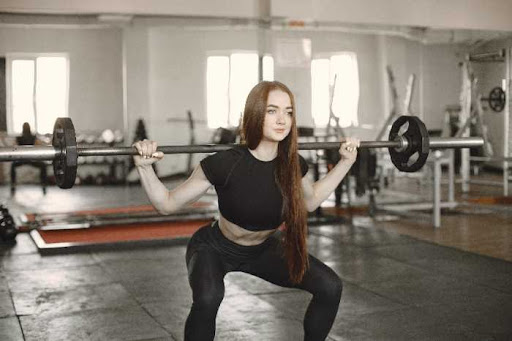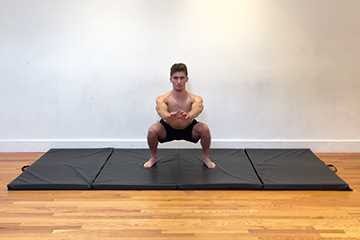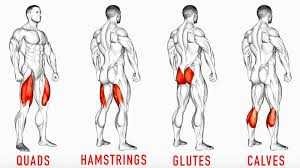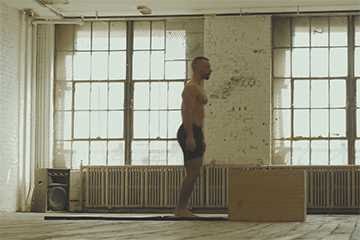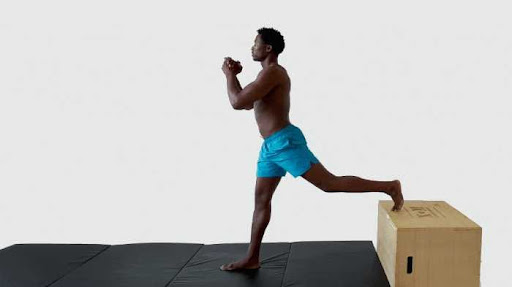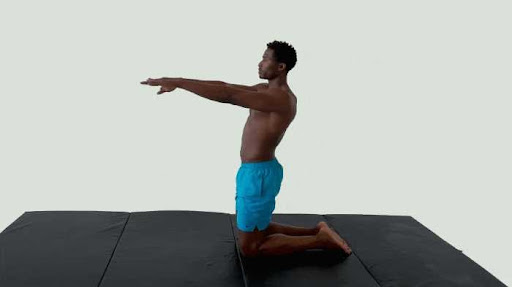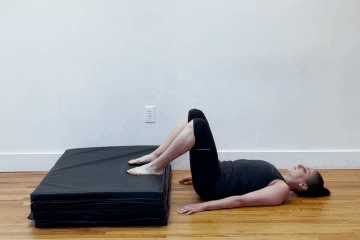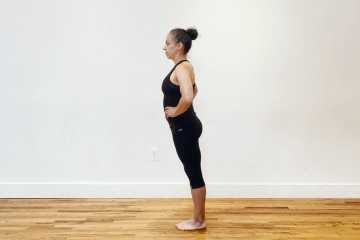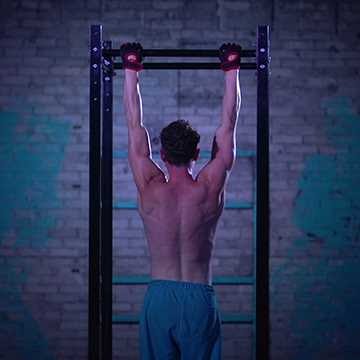
Join the tribe of Movement & Calisthenics Athlete – People just like you that are working with their own body weight to get strength, lose fat build muscle, recover from injuries and live their best lives!
If you are looking for a way to build stronger, thicker legs, then read on!
Most of us want to have a great set of legs. Whether it’s for looking good in short shorts or just being able to run faster, the size and shape of your legs are important.
Heavy squats and deadlifts are a popular go-to for bigger legs and there’s nothing wrong with that. Add dumbbell lunges and other weighted leg exercises, then you are guaranteed to build muscles.
But what if I told you that there is no need for expensive equipment?
Not everyone has access to a squat rack or expensive gym memberships.
Building bigger thighs, strong glutes, and tree-trunk calves are possible with bodyweight exercises.
If this sounds like something you’re interested in, keep reading!
Triggering muscle growth with bodyweight
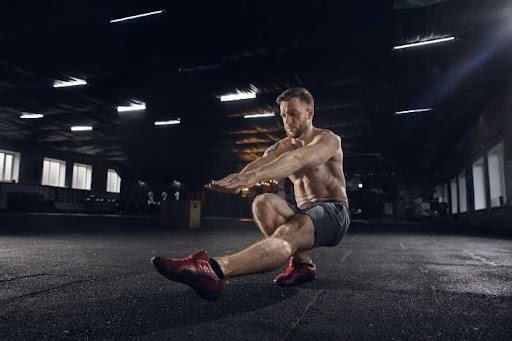
Calisthenics can build leg muscles and much more! Photo from Freepik
To grow your muscles you need to “break” with your training.
Training your legs is very much similar to training the rest of your body. You need to simply challenge them every session by choosing the proper exercises that suits also your level. This means that sessions should be progressive over time.
If you want to understand how you can calisthenics build mass, read this article, right here — > How to Gain Muscle Mass using Bodyweight Only
Breaking the myth!
You can master a lever and keep your legs big, but it’s going to be a challenge!
Okay. So high-level calisthenics athletes are usually perceived as having “inadequate” leg muscle size or most commonly known as “chicken legs”. Because of this, people think calisthenics leg exercises cannot support muscle growth in the lower body.
HOWEVER, they are just not simply seeing the fact that these top-level athletes specialize in upper body skills, and having big, heavy legs would be disadvantageous in their goals. Most of them still train their legs but not to increase their size.
Calisthenics generalist athletes tend to show more leg muscle size. Their leg training shows that it is possible to build leg mass and calisthenics, as the method of choice, isn’t a hindrance in achieving this goal.
Do I need weights to build bigger thighs?
Weighted back squats: one of the favorites for developing enormous legs and tight booty. Photo from Freepik
Don’t get us wrong. Weightlifting exercises are fantastic for building muscle mass for the legs and for the whole body.
But that doesn’t mean it’s necessary and the only way to go.
Calisthenics is still resistance training. Although it may seem that calisthenics is limited in progressive factors to stimulate growth compared to weight training, calisthenics leg workouts can build muscle if proper factors to build general muscle mass are strategically implemented.
Weighted leg exercises are convenient due to the straightforward approach to progression. Just add weight or reps, then you are good to go.
But calisthenics exercises have more to offer such as teaching new skills, improving balance, mobility (add progression article) all while building bigger legs.
Along with the proper progressive training (increasing challenge), two factors are also vital to facilitate muscle building effects as we already mentioned:
- Nutrition – How many calories is a large determining factor. Eat at a caloric surplus and meet YOUR protein requirement
- Sleep and recovery – the quality of sleep and managing your daily stress
Without those tho, even if you’re training efficiently with maximum effort, you will never gain weight, you will never build muscle, nor improve muscle definition.
Here are 5 tips to get bigger legs so you can get the idea of how to approach your training regimen.
5 Tips on how to grow your legs with just your body weight🔥
High volume workout
As mentioned earlier, we are limited to our body weight to directly increase the load or how heavy an exercise is.
For beginners, then bodyweight can be a challenge. But if you’re already experienced or advanced who have mastered the calisthenics basics, making the exercise heavier without weight can be challenging.
If that’s the case, simply add more volume to your training!
Resistance training volume refers to the total amount of work performed during a training session. We can express it simply through sets X reps in relation to the exercise progression you are doing.
If you’re doing bodyweight squats but unable to proceed to pistol squats due to other weaknesses you have to work on, you can continue to build muscle by increasing your training volume instead.
A 2012 study shows that volume can play a heavier role in inducing muscle growth than how heavy an exercise is.
The suggested number of sets is usually chained to 3-5 sets, then 8-12 reps per exercise.
But since we are working with bodyweight, you can train for 4-6 sets of 10 -50 reps because of the limited loading we apply. What matters most in hypertrophy is training near failure and exerting maximal effort each rep.
So aim for good proper form and a full range of motion to activate muscle fibers and induce metabolic stress and mechanical tension, which are crucial factors in developing your legs.
This holds true not only for your leg training but for the whole body, like when doing push-ups when it’s too easy. Aim for volume.
The main disadvantage of this type of training is that it will mostly take longer workouts, but it’s definitely worth your time if you want your legs as thick as a tree trunk!
There’s also evidence that training with high volume for the lower body together with high intensity for the upper body promotes superior hypertrophy and fat loss at the same time!
Hitting the muscles
Your legs consist of multiple muscle groups. Primarily the glutes, quadriceps, hamstrings, and calves.
You can already target these muscles through compound movements such as the squat, BUT squats, for example, provide different levels of stimulation for each muscle. So training squats alone will not maximize your leg development since muscles like the hamstrings and calves can lag.
Using “isolation exercises”
The solution is to target these muscles specifically with different exercises other than the squat.
Below are the top exercises you can use to hit and “isolate” the major muscle group. Take more of the air quotes on isolate since these aren’t true isolation movements.
Glutes
The glutes are one of the favorites because when you develop the glutes, you get a good-looking booty, and to be fair, everybody likes a good booty on men and women.
The exercise of choice for us is the step-ups. Although it can also be a quad-dominant exercise, following these guidelines below will help you engage your glutes more.
How to perform glute-dominant step-up:
- Stand with your feet shoulder-width apart in front of an elevated surface. Step your right leg onto the surface.
- Lunge forward, then drive down from the heel to step up into a standing position until leg straight.
- Lower back down to the starting position with control and repeat for reps.
- Reap for the left leg as well.
Coaching Pointers:
- Hips forward
- A slight forward lean when lunging to activate the glutes
- Vertical shin
Quads
Quads are already very much engaged in the regular squat, but this doesn’t mean you can’t put more emphasis on it!
Two exercises would fit best for quad activation: lunges and quad extensions.
There are different forms you can do with the lunges. We prefer using the Bulgarian split squat variation. You just need an elevated surface to place your foot, then expect the quads to burn up.
How to perform Bulgarian lunges:
- Begin in a standing position near an elevated surface behind you. Place one foot; you can start with your left foot behind. Then your right foot is the front foot.
- Lower down by bending your knee until thighs parallel to the knee.
- Push back up to the top position, then repeat for reps.
- Don’t forget to do the exercise with the other leg leading.
Coaching pointers:
- Hips squared
- Knee under your front foot
- Chest up
- 90-degree angle for both legs
- Stand with your feet shoulder-width apart. Maintain that distance even if you have already put your left foot on the elevated surface.
- In case you want a weighted variation, choose the right weight and hold a dumbbell vertically.
- Don’t lean forward as you lower down.
Bodyweight quad extension is amazing for building muscle while also improving its mobility. It’s not the most popular quad development exercise, but your quad muscle fibers will surely fire up with the exercise. As a cue, think of pushing your shin against the floor to engage your quads throughout the movement.
How to perform quad extensions:
- Kneel down with knees shoulder-width apart with your torso straight and hip tilted forward (posterior pelvic tilt) to engage the core. This is your starting position.
- Maintain a rigid upper body then start to descend backward by hinging at the knees.
- Slowly lower down until your mobility permits.
- Hold the bottom position then reverse the motion while keeping the torso straight.
Coaching pointers:
- Hips pushed
- Core engaged
- Knees shoulder-width apart or just slightly wider if you are comfortable
- Toes pointed or balls of your feet the planted on the ground. It depends on your preference
Hamstrings
Hamstrings are another large muscle group just below the glutes that facilitate many movement functions. Think of the opposite of the quads.
For this exercise, will be focusing on the glute-ham bridge. If you’re advanced enough, you can proceed to nordic curl variations, but the bridge also has a progression that might be already enough to stimulate your hammies.
Elevated variation to make it more challenging for your glutes
How to perform glute-ham bridge:
- Lie down as your starting position. Feet hip-width apart. Knees slightly bent. Feet flat on the floor.
- Push down through your heels and push your hips upward.
- Pause at the top position for a few seconds.
- Lower down with control.
- Repeat for reps.
Coaching pointers:
- For an added challenge, move your feet further, use one leg at a time, or elevate your feet to a surface
- Avoid arching of the lower back
- Posterior pelvic tilt
- Engage your core
- Focus on contracting your hamstrings and glutes
Calves
Ah yes. It has always been the dream to get bigger calves so your legs won’t look that too thin anymore.
It’s not impossible to develop your calves with just your body weight. You just have to follow our tips and use the exercise below with high volume.
How to perform calf raises:
- Stand with your feet slightly wider than your shoulders. This is your starting position.
- Push down on the balls of your feet are your heels as high as you can while keeping the legs straight.
- Hold the top position for a few seconds.
- Lower down with control.
- Repeat for reps.
Coaching pointers:
- Ideally, you would want to stand on the edge of an elevated surface to increase the range of motion
- Don’t bend your knees for this variation but you do the raises in the deep squat position to target the inner calf muscle.
- Use unilateral variation for added intensity. Finish one set from your left leg before moving to your right leg or just begin with the non-dominant leg.
Using the right progressions
While volume plays an integral role, it’s still a good idea to work with a suitable progression that challenges you.
Using a too easy exercise, then you might be doing 200 reps per set just to get to near fatigue. You can still muscle but it will take some time in your workout. Using a too difficult exercise is dangerous and can cause injuries if implemented too early in your journey.
So choose a progression that provides enough challenge for you while still being able to perform the exercise with good form.
Let’s take squats as an example below.
Squats
Squats seem easy on paper. To perform a rep, you need to
- Stand with your feet hip-width apart.
- Bend your knees and lower down until your butt is a few inches away from your floor.
- Push back up to the starting position.
Sounds easy but surprisingly, not many people can achieve the full range of motion of squats. You can’t build muscle if you can’t perform the exercise correctly. So if’s too difficult, use box squats to limit your range of motion as you grow stronger.
For more advanced individuals, train towards pistol squats and use its progressions such as the single-leg split squats, negatives, and assisted variations to gradually build strength. Just don’t forget to train the opposite leg when working with one leg
Increasing training frequency
Since you will be working with compound and isolation exercises, it’s best to train your legs 2 times per week to maximize their growth potential. You can definitely get away once per week this is not optimized.
A 2016 meta-analysis, however, supports 3 times per week best results, however, meeting the proper balance of intensity and training volume is required to avoid overtraining.
When training with bodyweight, it’s easy to get overconfident and relaxed that doing once per week is enough, but if you’re not pushing hard enough, you won’t induce muscle growth.
Staying consistent with a 2 times per week training schedule will mostly be the best and most sustainable approach with most people.
How to combine with upper body training?
So now you have an idea and some exercises to work with for your lower body workout routine, the next issue is how to integrate it with your upper body routine.
Upper-split vs full body
Doing both leg training and upper body calisthenics on the same day is not a bad idea. It’s basically a full-body workout which is great, especially for beginners who are just starting to develop their strength.
But doing this approach will lengthen your training time and hinder you from prioritizing your legs in the training session.
A better option would be is to split your upper body workout with your lower body training. This way, you can have a full session dedicated to your legs which further speeds up the hypertrophy process.
Alternate your leg training with your upper body training to avoid overtraining and working the same muscles on consecutive days.
Here is a solid leg workout routine with a complete guide on how to thicken them up with just your body weight: Calisthenics Legs Workout
Summing up
Calisthenics is a fantastic approach to develop huge legs that move with function too!
Follow the training protocols above and keep your nutrition, and recovery aligned with your goal, then you will surely be growing your legs for days.
However, training protocols seem complicated with the vast factors affecting your training and development. In addition to that, many beginner/intermediate/advanced programs cannot cater properly to the individual differences we all have.
To maximize leg growth, you need a structured program that is personalized to take into consideration these differences.
It’s like saying having a personal trainer is your best course of action, but then again, hiring one is expensive.
But now, you can get a personal trainer with a tap on your mobile device!
Maintaining your health, staying fit, getting bigger legs that can move without any restrictions shouldn’t be complicated! It’s a necessity in life.
You don’t need to plan your workout because The Movement Athlete can do it for you. The first step to personalization is knowing where you are in your fitness journey.
Begin your personalized training below. 🎯
TAKE THE ASSESSMENT NOW!


